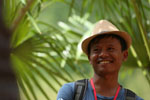In Rangoon’s Kawhmu Township, where thousands gathered on Saturday to greet wildly popular opposition leader Aung San Suu Kyi, not everyone is planning on heading to their local polling station on Nov. 8.
Several locals who spoke to The Irrawaddy during an earlier campaign rally held by Suu Kyi in the township’s Ma Zwe Seik village last month said they were more focused on their daily survival than the business of politics.
Ma Win Htay, who was selling flowers at the rally, said she did not have time to check if her name was correctly recorded on the voter list.
“I have a hard life here dealing with my businesses and just surviving,” she said. “I am not interested in the election.”
Her sentiment was echoed by others in Kawhmu, where the National League for Democracy (NLD) chairwoman is running for a Lower House seat. Two other women selling fast food at the Ma Zwe Seik rally also said they had no interest in the coming election and spoke of their day-to-day struggles.

Locals may argue that all Kawhmu has to show after five years of political “reform” in Burma is a new bitumen road—which is nevertheless an improvement when compared to the potholed streets of neighboring constituencies.
Suu Kyi appears aware of such criticism, reminding supporters that the NLD was not the government and that the latter bore present responsibility for improving people’s livelihoods.
“Give your vote to our NLD,” she told supporters in Kawhmu last month. “If we become the government, we will give you a job. We will let you work based on your skills.”
Meanwhile, the incumbent government has taken to Facebook to defend its record since President Thein Sein assumed office in 2011.
A series of videos produced by the President’s Office and released online highlight how the country is moving forward, informing of the president’s role in permitting press freedoms, trade unions, the right to protest and the facilitation of a telecommunications boom.
The footage is aimed squarely at winning over the electorate and, with its ample references to the achievements of the “reformist” Thein Sein, seems to buttress the remarks of a ruling party official last week that the president would again be selected as the party’s choice for the top job post-November.
In the Union Solidarity and Development Party (USDP)’s election campaigns, official photos of the President, who is also acting chairman of the party, have also been prominent.
But no matter who becomes president in 2016, many, like the women quoted above, feel it will have no immediate impact on their lives. People across Burma need better health care, education and employment opportunities. The majority of Burmese make a living in agriculture, and policies in this sector will be crucial to reducing poverty.
There is much to do for a new government.
Under the five-year term of Thein Sein, there was much positive rhetoric, both domestically and abroad, about economic and social reform. But while some positive changes have unarguably been enacted, the plight of the majority of Burmese, particularly in ethnic areas, remains the same.
Many ethnic people feel the much-touted reform process is just a veneer for the benefit of the international community and pursued in order that the establishment can cling to power.
Thein Sein has been unable to halt fighting in Kachin and Shan states, despite a so-called nationwide ceasefire agreement recently signed between Naypyidaw and eight ethnic armed groups.
Some USDP candidates and their supporters appear to have stooped to invoking religion in a dangerous, not to mention unlawful, attempt to woo voters. Only last week, Burma Army chief Snr-Gen Min Aung Hlaing advised military personnel to vote for candidates who could “protect race and religion.”
If the ruling party wins in the coming election, we only need to look back on its current term to know what would lay ahead.
The majority of Burmese will be hoping for a result that can affect real change in our country and that is felt in local communities.

















